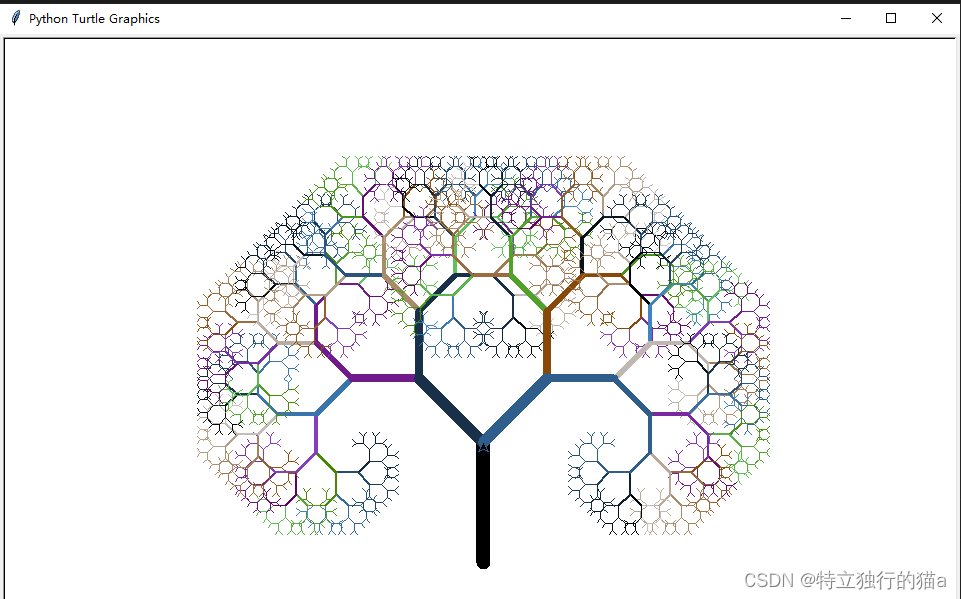学Turtle库,其实就是学数学,而且还能提高对数学和学习的兴趣。Turtle库还能够帮助孩子更好地理解几何学和数学概念,比如角度、比例、几何图形的性质等等,是Python中一个很有趣的库。
前言
Turtle库是Python中一个很有趣的库,可以用来绘制各种图形,比如直线、圆、正方形等等。掌握Turtle库的意义在于可以培养孩子的创造力和想象力,让他们通过编写代码来实现自己的创意,同时也可以提高他们的编程能力和逻辑思维能力。此外,Turtle库还能够帮助孩子更好地理解几何学和数学概念,比如角度、比例、几何图形的性质等等,学Turtle库其实就是学数学,但更有趣味性。
turtle库介绍
Turtle库是Python的一个标准库,提供了一个绘图的海龟机器人,可以使用Python代码控制海龟机器人的移动和动作,从而实现绘制图形的功能。Turtle库支持绘制直线、圆、椭圆、曲线、填充颜色等功能,可以用来绘制各种各样的图形和图案。使用Turtle库可以加深对Python语言的理解和掌握,同时也可以进行艺术创作和教育活动。
Python内置了turtle库。在1966年,Seymour Papert和Wally Feurzig发明了一种专门给儿童学习编程的语言——LOGO语言,它的特色就是通过编程指挥一个小海龟(turtle)在屏幕上绘图。海龟绘图(Turtle Graphics)后来被移植到各种高级语言中,Python内置了turtle,基本上100%复制了原始的Turtle Graphics的所有功能。
turtle的帮助文档:turtleturtle绘图作品:海龟绘图turtle库的使用
使用前需先引入库,可以使用 from turtle import * 或者 import turtle。前者使用方法不需要加 turtle,后者需要加turtle。
简单示例:
import turtle# 创建一个Turtle对象t = turtle.Turtle()#turtle.setup(width,height,startx,starty)# 移动Turtle对象前进100步t.forward(100)# 向左旋转Turtle对象90度t.left(90)# 移动Turtle对象前进50步t.forward(50)# 创建另一个Turtle对象t2 = turtle.Turtle()# 移动Turtle对象t2前进80步t2.forward(80)# 绘制线段连接两个Turtle对象的位置t2.goto(t.xcor(), t.ycor())# 调用done()使得窗口等待被关闭,否则将立刻关闭窗口:turtle.done()画出长方形
从简单的开始,画个长方形。
# 导入turtle包的所有内容:from turtle import *# 设置笔刷宽度:width(4)# 前进:forward(200)# 右转90度:right(90)# 笔刷颜色:pencolor('red')forward(100)right(90)pencolor('green')forward(200)right(90)pencolor('blue')forward(100)right(90)# 调用done()使得窗口等待被关闭,否则将立刻关闭窗口:done()从程序代码可以看出,海龟绘图就是指挥海龟前进、转向,海龟移动的轨迹就是绘制的线条。要绘制一个长方形,只需要让海龟前进、右转90度,反复4次。
调用width()函数可以设置笔刷宽度,调用pencolor()函数可以设置颜色。更多操作请参考turtle库的说明。绘图完成后,记得调用done()函数,让窗口进入消息循环,等待被关闭。否则,由于Python进程会立刻结束,将导致窗口被立刻关闭。
绘制任意多边形
增加点难度,学习下数学的几何知识。
多边形的内角公式: 内角 = (n-2) * 180 / n,其中n是多边形的边数。
多边形的所有内角之和等于 180*(n - 2),其中 n 是多边形的边数。
以正五边形为例,将n设置为5,代入公式得到 (5-2) * 180 / 5 = 3 * 180 / 5 = 108度,因此,正五边形的每个内角为108度。
其实类似这类画图问题,都是数学问题,算对了角度,就很容易画了。
多边形内角公式的推导,来学习下数数学知识。
多边形的内角是指多边形内部的任意两个相邻顶点之间的夹角。
证法一:
因为每个三角形的内角之和为 180°,一个n边行,可以分为n-2个三角形。因此,多边形的内角和等于 180*(n - 2)。那么每个内角= (n-2) * 180 / n。
证法二:
任意凸多边形的外角和都为360°,在一个n边形中,每个顶点的外角度数为360度/n。由于多边形有n个顶点,所以外角度数的总和为360度。因此可以得到公式:n * 外角度数 = 360度,即外角度数 = 360度 / n。内角+外角=180度,可以得到多边形的内角公式:内角 = 180度 - (360度 / n) = (n - 2) * 180度 / n。
例如,在一个三角形中,每个顶点的外角度数为 360° / 3 = 120°。 在一个四边形中,每个顶点的外角度数为 360° / 4 = 90°。 在一个五边形中,每个顶点的外角度数为 360° / 5 = 72°。
举例,画几个正五边形:
from turtle import *import timedef draw5(x, y): pu() goto(x, y) pd() # set heading: 0 seth(0) for i in range(5): fd(40) rt(72) time.sleep(1)for x in range(0, 250, 50): draw5(x, 0)done()出题,如何绘制出五角星?
根据上述公式,如果要绘制五角星,关键是得知道每次转向多少角度?
五角星是144度。为什么是144度,你知道吗?因为正五边形的内角是108度,则它的的补角是72度,五角星的每个角是180-72-72=36度,因此 每次转向180-36 = 144 度。
#绘制一个五角星from turtle import *import timedef drawStar(x, y): pu() goto(x, y) pd() # set heading: 0 seth(0) for i in range(5): fd(110) rt(144) time.sleep(1)drawStar(0,0)done()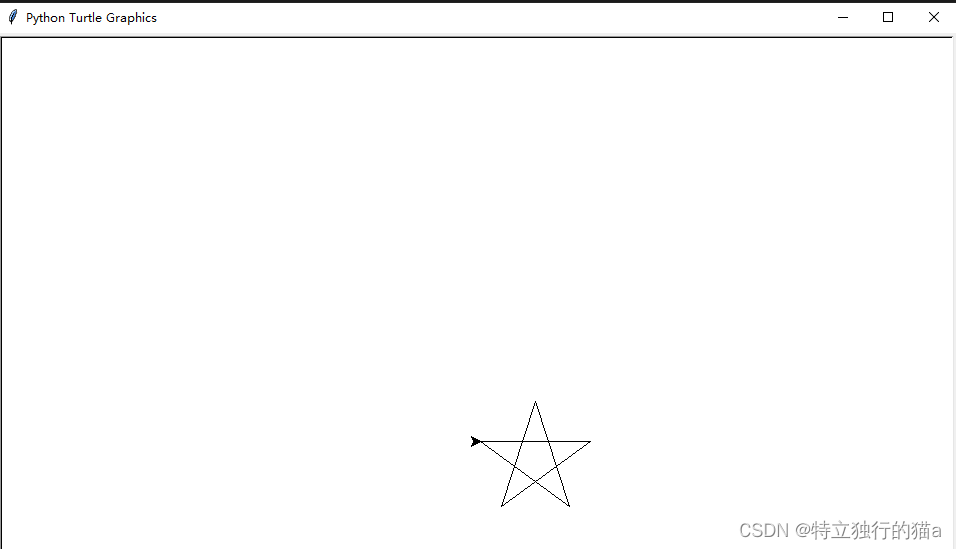
以此类推,你能绘制出六角星吗?
也很简单,关键是知道六角星的每个角的角度,求得转向角度。根据多边形的内角公式,多边形内角 = (n-2) * 180 / n,其中n是多边形的边数。
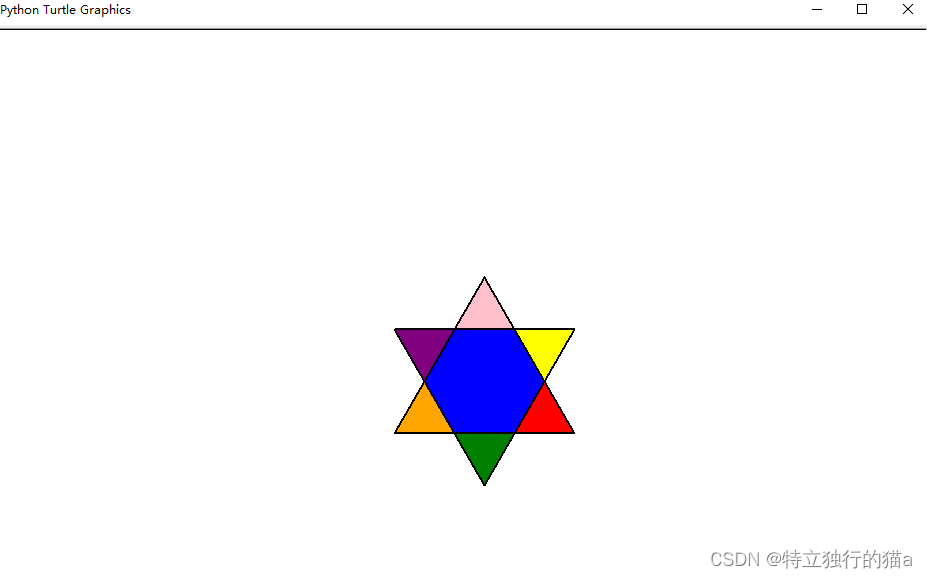
先画出每个小三角形,每次转向60度,再画出剩余5个小三角形,总共是6个小三角形组成了六边形。
from turtle import *def triangle(): pensize(2) pencolor('black') for i in range(3): fd(60) right(120) def test(): colors=['green','red','yellow','pink','purple','orange'] speed(1) for i in range(6): begin_fill() fillcolor(colors[i]) triangle() fd(60) left(60) #以坐标系为基准,左转60° end_fill() #填充中心颜色 fillcolor("blue") begin_fill() for i in range(6): fd(60) left(60) end_fill() ht()#隐藏画笔 done() test()from turtle import *def triangle(x): pensize(2) pencolor('black') for i in range(3): fd(x) right(120)def main(): speed(8) colors=['green','red','yellow','blue'] for j in range(1,7): for i in range(4): if j >= 2: triangle(160 + j * 10) left(90) else: fillcolor(colors[i]) begin_fill() triangle(160) left(90) end_fill() ht()main()done()猜一猜以下代码将画出什么图形?
from turtle import *def triangle(): pensize(2) pencolor('black') for i in range(3): fd(160) right(120)def test(): penup() setpos(-100,140)#画笔移动到一个绝对坐标。(开始默认画笔居中) pendown() speed(5) colors=['green','red','pink','purple','blue','yellow','orange'] for i in range(6): fillcolor(colors[i]) begin_fill() triangle() fd(160) right(60) end_fill() ht()#执行test()done()出题,你能画出如下的风车吗?
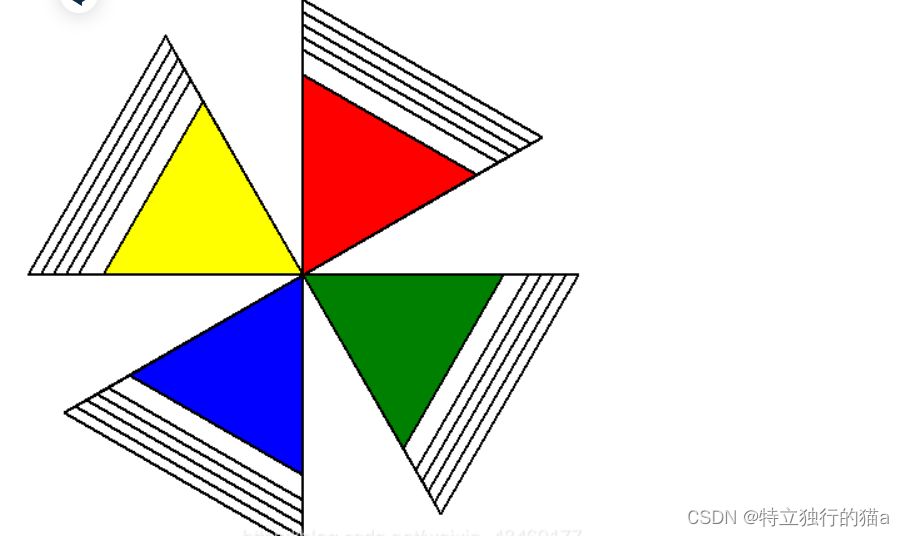
画个龙卷风
from turtle import *# 龙卷风setup(800,600)pensize(1)speed(6)colors=['green','red','yellow','grey','orange','blue','pink','purple']bgcolor('black')for i in range(1,10): pencolor(colors[i%8]) penup() goto(5*i,0) pendown() circle(10*i) done() 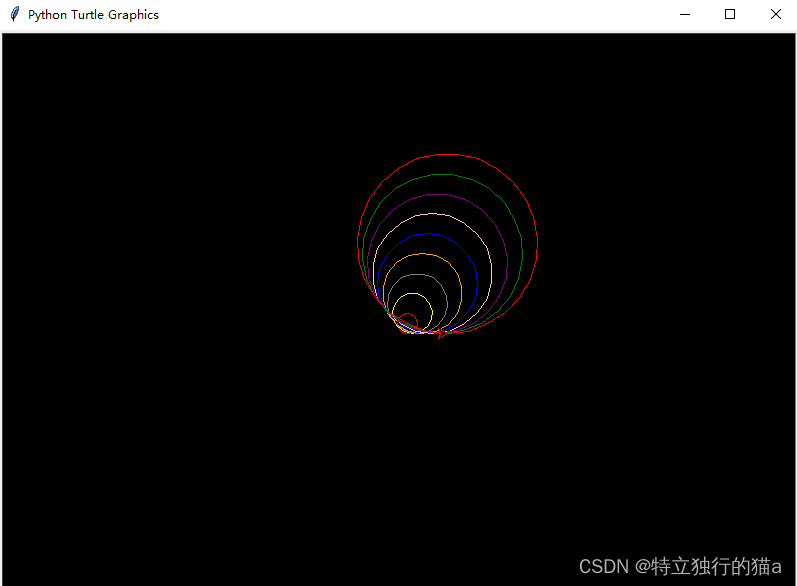
同心圆(箭靶)
# 同心圆from turtle import *setup(800, 600, 450, 50)pensize(5)bgcolor('white')speed('fastest')colors = ['blue', 'yellow', 'red', 'green', 'white', 'black', 'orange', 'grey']for i in range(10, 1, -1): penup() goto(0, -20 * i) pendown() begin_fill() fillcolor(colors[i % 4]) circle(20 * i) end_fill()hideturtle()done()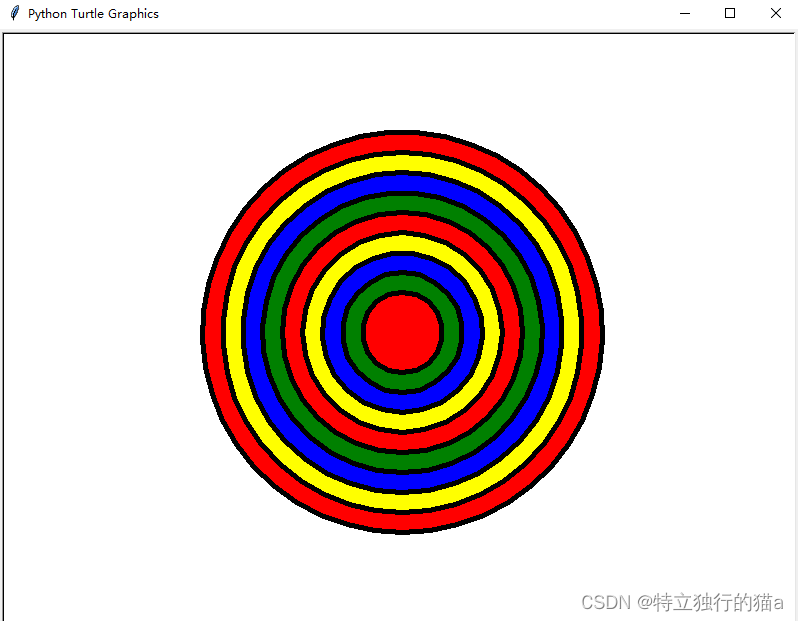
turtle主要函数介绍
绝对坐标
海龟初始位置为(0,0),位于画布中央。
海龟默认朝向右侧。(在turtle模块中,可使用setheading()函数(可简写为seth)用于设置海龟的朝向。它的作用是设置海龟当前的前进方向,参数是一个0-360之间的整数,表示海龟的朝向角度。例如setheading(90)将使海龟朝向上方,seth(180)将使朝向指向左方。
行进函数
turtle.goto(x,y,从当前位置到达任何位置(X,Y)。
海龟无论何处,面对的方向是前进方向。
前进函数:turtle.fd(),向前移动指定的距离。
后退函数:turtle.bk(),向后移动指定的距离。
画弧函数:turtle.circle(r, angle) 以左侧r像素处为圆心,逆时针旋转angle的角度。
朝向函数:turtle.seth(angle)朝向绝对方向angle。(海龟默认朝向右侧,设置90,则逆时针转向指向正上方,设置为180则将使朝向指向左侧。)
right()和left()函数用于设置海龟的转向角度。
right(angle)函数用于将海龟向右旋转指定的角度。参数angle是一个整数,表示海龟要旋转的角度。例如,right(90)将使海龟向右旋转90度。
left(angle)函数用于将海龟向左旋转指定的角度。参数angle是一个整数,表示海龟要旋转的角度。例如left(90)将使海龟向左旋转90度。 这两个函数可以用于控制海龟的行走方向和绘制图形的方向。在使用这两个函数时,需要注意它们设置的是海龟的相对转向角度,而不是绝对转向角度。也就是说,调用right()函数后,海龟的面向方向会向右旋转,而调用left()函数后,海龟的面向方向会向左旋转。
turtle.penup() 画笔抬起
turtle.pendown() 画笔落下
turtle.pensize() 海龟腰围
turtle.pencolor() 画笔颜色
turtle.speed() 设置移动速度,其中的参数值表示海龟的速度等级,取值范围为[0, 10],注意其中0也是表示最快的速度,1则是最慢,10也是表示最快的速度,默认速度应该是5(normal)。
如果输入的数字大于10或小于0.5,则速度设置为0。速度字符串通过以下方式映射到速度值: ‘fastest’:0‘fast’:10‘normal’:6‘slow’:3‘slowest’:1turtle.home() 返回原点(0,0)位置(屏幕正中央),朝向右。
绘制复杂的图形
注:部分资源引用自《Python创意编程100例turtle篇》。如有侵权请告知删除。
美丽的树
from turtle import *# 设置色彩模式是RGB:colormode(255)lt(90)lv = 14l = 120s = 45width(lv)# 初始化RGB颜色:r = 0g = 0b = 0pencolor(r, g, b)penup()bk(l)pendown()fd(l)def draw_tree(l, level): global r, g, b # save the current pen width w = width() # narrow the pen width width(w * 3.0 / 4.0) # set color: r = r + 1 g = g + 2 b = b + 3 pencolor(r % 200, g % 200, b % 200) l = 3.0 / 4.0 * l lt(s) fd(l) if level < lv: draw_tree(l, level + 1) bk(l) rt(2 * s) fd(l) if level < lv: draw_tree(l, level + 1) bk(l) lt(s) # restore the previous pen width width(w)speed("fastest")draw_tree(l, 4)done()彩色大蟒蛇
import turtleturtle.setup(650, 350,200,200)turtle.penup()turtle.fd(-250)turtle.pendown()turtle.pensize(25)colors=['green','blue','yellow','orange','pink','purple']turtle.seth(-40)for i in range(4): turtle.color(colors[i])#选择索引从0~3的颜色 turtle.circle(40, 80)#上半弧度 turtle.circle(-40, 80)#下半弧度turtle.color(colors[5])turtle.circle(40, 80/2)turtle.fd(40)turtle.circle(16, 180)turtle.fd(40 * 2/3)turtle.done()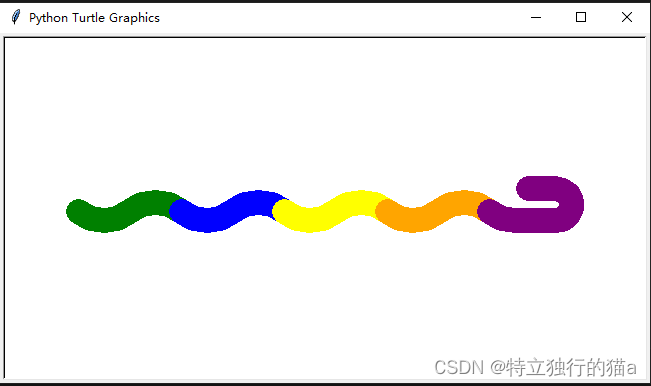
画小猪佩奇
# coding=utf-8 import turtle as t t.pensize(4)t.hideturtle()t.colormode(255)t.color((255, 155, 192), "pink")t.setup(840, 500)t.speed(10) # 鼻子t.pu()t.goto(-100, 100)t.pd()t.seth(-30)t.begin_fill()a = 0.4for i in range(120): if 0 <= i < 30 or 60 <= i < 90: a = a + 0.08 t.lt(3) # 向左转3度 t.fd(a) # 向前走a的步长 else: a = a - 0.08 t.lt(3) t.fd(a)t.end_fill() t.pu()t.seth(90)t.fd(25)t.seth(0)t.fd(10)t.pd()t.pencolor(255, 155, 192)t.seth(10)t.begin_fill()t.circle(5)t.color(160, 82, 45)t.end_fill() t.pu()t.seth(0)t.fd(20)t.pd()t.pencolor(255, 155, 192)t.seth(10)t.begin_fill()t.circle(5)t.color(160, 82, 45)t.end_fill() # 头t.color((255, 155, 192), "pink")t.pu()t.seth(90)t.fd(41)t.seth(0)t.fd(0)t.pd()t.begin_fill()t.seth(180)t.circle(300, -30)t.circle(100, -60)t.circle(80, -100)t.circle(150, -20)t.circle(60, -95)t.seth(161)t.circle(-300, 15)t.pu()t.goto(-100, 100)t.pd()t.seth(-30)a = 0.4for i in range(60): if 0 <= i < 30 or 60 <= i < 90: a = a + 0.08 t.lt(3) # 向左转3度 t.fd(a) # 向前走a的步长 else: a = a - 0.08 t.lt(3) t.fd(a)t.end_fill() # 耳朵t.color((255, 155, 192), "pink")t.pu()t.seth(90)t.fd(-7)t.seth(0)t.fd(70)t.pd()t.begin_fill()t.seth(100)t.circle(-50, 50)t.circle(-10, 120)t.circle(-50, 54)t.end_fill() t.pu()t.seth(90)t.fd(-12)t.seth(0)t.fd(30)t.pd()t.begin_fill()t.seth(100)t.circle(-50, 50)t.circle(-10, 120)t.circle(-50, 56)t.end_fill() # 眼睛t.color((255, 155, 192), "white")t.pu()t.seth(90)t.fd(-20)t.seth(0)t.fd(-95)t.pd()t.begin_fill()t.circle(15)t.end_fill() t.color("black")t.pu()t.seth(90)t.fd(12)t.seth(0)t.fd(-3)t.pd()t.begin_fill()t.circle(3)t.end_fill() t.color((255, 155, 192), "white")t.pu()t.seth(90)t.fd(-25)t.seth(0)t.fd(40)t.pd()t.begin_fill()t.circle(15)t.end_fill() t.color("black")t.pu()t.seth(90)t.fd(12)t.seth(0)t.fd(-3)t.pd()t.begin_fill()t.circle(3)t.end_fill() # 腮t.color((255, 155, 192))t.pu()t.seth(90)t.fd(-95)t.seth(0)t.fd(65)t.pd()t.begin_fill()t.circle(30)t.end_fill() # 嘴t.color(239, 69, 19)t.pu()t.seth(90)t.fd(15)t.seth(0)t.fd(-100)t.pd()t.seth(-80)t.circle(30, 40)t.circle(40, 80) # 身体t.color("red", (255, 99, 71))t.pu()t.seth(90)t.fd(-20)t.seth(0)t.fd(-78)t.pd()t.begin_fill()t.seth(-130)t.circle(100, 10)t.circle(300, 30)t.seth(0)t.fd(230)t.seth(90)t.circle(300, 30)t.circle(100, 3)t.color((255, 155, 192), (255, 100, 100))t.seth(-135)t.circle(-80, 63)t.circle(-150, 24)t.end_fill() # 手t.color((255, 155, 192))t.pu()t.seth(90)t.fd(-40)t.seth(0)t.fd(-27)t.pd()t.seth(-160)t.circle(300, 15)t.pu()t.seth(90)t.fd(15)t.seth(0)t.fd(0)t.pd()t.seth(-10)t.circle(-20, 90) t.pu()t.seth(90)t.fd(30)t.seth(0)t.fd(237)t.pd()t.seth(-20)t.circle(-300, 15)t.pu()t.seth(90)t.fd(20)t.seth(0)t.fd(0)t.pd()t.seth(-170)t.circle(20, 90) # 脚t.pensize(10)t.color((240, 128, 128))t.pu()t.seth(90)t.fd(-75)t.seth(0)t.fd(-180)t.pd()t.seth(-90)t.fd(40)t.seth(-180)t.color("black")t.pensize(15)t.fd(20) t.pensize(10)t.color((240, 128, 128))t.pu()t.seth(90)t.fd(40)t.seth(0)t.fd(90)t.pd()t.seth(-90)t.fd(40)t.seth(-180)t.color("black")t.pensize(15)t.fd(20) # 尾巴t.pensize(4)t.color((255, 155, 192))t.pu()t.seth(90)t.fd(70)t.seth(0)t.fd(95)t.pd()t.seth(0)t.circle(70, 20)t.circle(10, 330)t.circle(70, 30)t.done()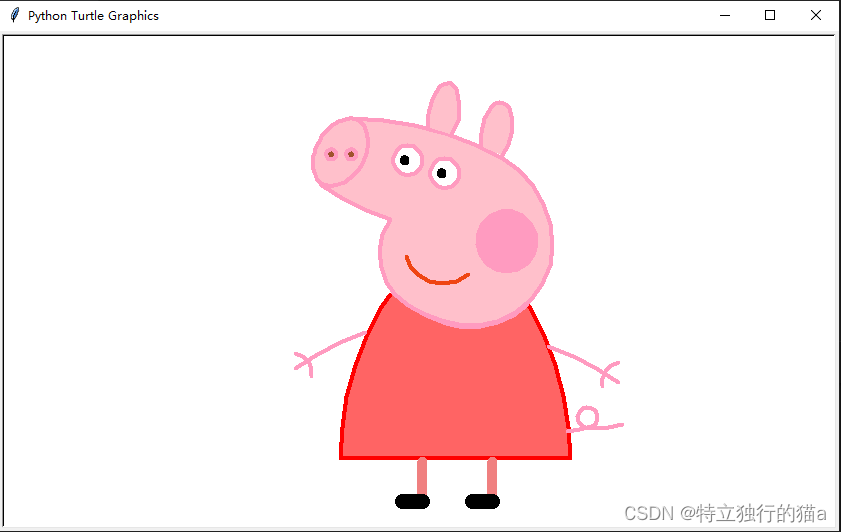
画钟表
# -*- coding:utf-8 –*-# 用turtlr画时钟# 以自定义shape的方式实现import turtle as timport datetime as ddef skip(step): # 抬笔,跳到一个地方 t.penup() t.forward(step) t.pendown() def drawClock(radius): # 画表盘 t.speed(0) t.mode("logo") # 以Logo坐标、角度方式 t.hideturtle() t.pensize(7) t.home() # 回到圆点 for j in range(60): skip(radius) if (j % 5 == 0): t.forward(20) skip(-radius - 20) else: t.dot(5) skip(-radius) t.right(6) def makePoint(pointName, len): # 钟的指针,时针、分针、秒针 t.penup() t.home() t.begin_poly() t.back(0.1 * len) t.forward(len * 1.1) t.end_poly() poly = t.get_poly() t.register_shape(pointName, poly) # 注册为一个shape def drawPoint(): # 画指针 global hourPoint, minPoint, secPoint, fontWriter makePoint("hourPoint", 100) makePoint("minPoint", 120) makePoint("secPoint", 140) hourPoint = t.Pen() # 每个指针是一只新turtle hourPoint.shape("hourPoint") hourPoint.shapesize(1, 1, 6) minPoint = t.Pen() minPoint.shape("minPoint") minPoint.shapesize(1, 1, 4) secPoint = t.Pen() secPoint.shape("secPoint") secPoint.pencolor('red') fontWriter = t.Pen() fontWriter.pencolor('gray') fontWriter.hideturtle() def getWeekName(weekday): weekName = ['星期一', '星期二', '星期三', '星期四', '星期五', '星期六', '星期日'] return weekName[weekday]def getDate(year, month, day): return "%s-%s-%s" % (year, month, day)def realTime(): curr = d.datetime.now() curr_year = curr.year curr_month = curr.month curr_day = curr.day curr_hour = curr.hour curr_minute = curr.minute curr_second = curr.second curr_weekday = curr.weekday() t.tracer(False) secPoint.setheading(360 / 60 * curr_second) minPoint.setheading(360 / 60 * curr_minute) hourPoint.setheading(360 / 12 * curr_hour + 30 / 60 * curr_minute) fontWriter.clear() fontWriter.home() fontWriter.penup() fontWriter.forward(80) # 用turtle写文字 fontWriter.write(getWeekName(curr_weekday), align="center", font=("Courier", 14, "bold")) fontWriter.forward(-160) fontWriter.write(getDate(curr_year, curr_month, curr_day), align="center", font=("Courier", 14, "bold")) t.tracer(True) print(curr_second) t.ontimer(realTime, 100) # 每隔100毫秒调用一次realTime() def main(): t.tracer(False) drawClock(160) drawPoint() realTime() t.tracer(True) t.mainloop() if __name__ == '__main__': main()
画狮子头
import turtle as tdef hair(): # 画头发 t.penup() t.goto(-50, 150) t.pendown() t.fillcolor('#a2774d') t.begin_fill() for j in range(10): # 重复执行10次 t.setheading(60 - (j * 36)) # 每次调整初始角度 t.circle(-50, 120) # 画120度的弧 t.end_fill() def face(): # 画脸 t.penup() t.goto(0, 100) t.pendown() t.fillcolor('#f2ae20') t.begin_fill() t.setheading(180) t.circle(85) t.end_fill() # 下巴 t.circle(85, 120) t.fillcolor('white') t.begin_fill() t.circle(85, 120) t.setheading(135) t.circle(100, 95) t.end_fill() def ears(dir): # 画眼睛,dir用来设置方向,左右眼对称 t.penup() t.goto((0 - dir) * 30, 90) t.setheading(90) t.pendown() t.fillcolor('#f2ae20') t.begin_fill() t.circle(dir * 30) t.end_fill() t.penup() t.goto((0 - dir) * 40, 85) t.setheading(90) t.pendown() t.fillcolor('white') t.begin_fill() t.circle(dir * 17) t.end_fill() def nose(): # 画鼻子 t.penup() t.goto(20, 0) t.setheading(90) t.pendown() t.fillcolor('#a2774d') t.begin_fill() t.circle(20) t.end_fill() def eye(dir): # 画耳朵,dir用来设置方向,左右耳对称 t.penup() t.goto((0 - dir) * 30, 20) t.setheading(0) t.pendown() t.fillcolor('black') t.begin_fill() t.circle(10) t.end_fill() def mouth(): # 画嘴巴 t.penup() t.goto(0, 0) t.setheading(-90) t.pendown() t.forward(50) t.setheading(0) t.circle(80, 30) t.penup() t.goto(0, -50) t.setheading(180) t.pendown() t.circle(-80, 30) hair()ears(1)ears(-1)face()eye(1)eye(-1)mouth()nose()t.done()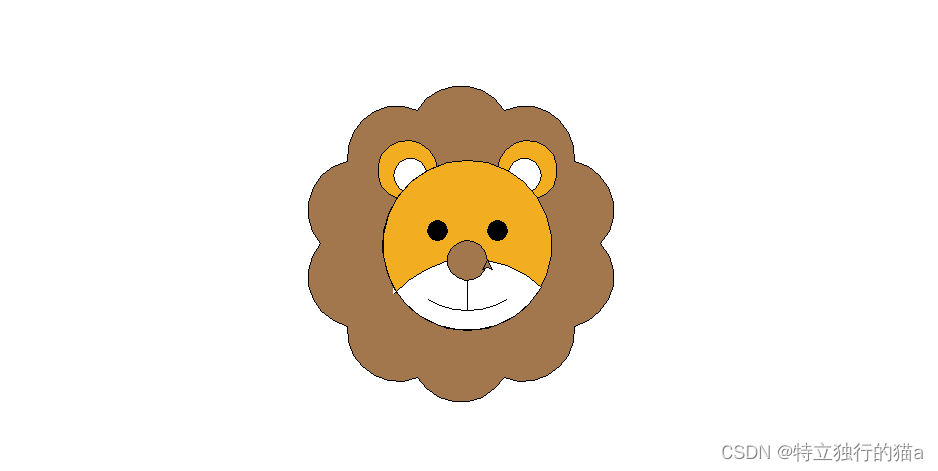
画朵小红花
import turtle as tt.speed(0) #花柄t.penup()t.goto(0,-150)t.pendown()t.pensize(2)t.setheading(90)t.color('brown')t.fd(300) #花瓣t.pensize(1)t.color('black','red')t.begin_fill()for i in range(10): t.left(45) t.circle(80,60) t.left(120) t.circle(80,60)t.end_fill() #叶子for i in range(2): t.penup() t.goto(0,10-50*i) x=20+80*i t.setheading(x) t.pendown() t.color('brown','green') t.begin_fill() t.circle(60,60) t.left(120) t.circle(60,60) t.end_fill()t.hideturtle()
浪漫樱花
from turtle import *from random import *from math import *def tree(n, l): pd () # 下笔 # 阴影效果 t = cos ( radians ( heading () + 45 ) ) / 8 + 0.25 pencolor ( t, t, t ) pensize ( n / 3 ) forward ( l ) # 画树枝 if n > 0: b = random () * 15 + 10 # 右分支偏转角度 c = random () * 15 + 10 # 左分支偏转角度 d = l * (random () * 0.25 + 0.7) # 下一个分支的长度 # 右转一定角度,画右分支 right ( b ) tree ( n - 1, d ) # 左转一定角度,画左分支 left ( b + c ) tree ( n - 1, d ) # 转回来 right ( c ) else: # 画叶子 right ( 90 ) n = cos ( radians ( heading () - 45 ) ) / 4 + 0.5 ran = random () # 这里相比于原来随机添加了填充的圆圈,让樱花叶子看起来更多一点 if (ran > 0.7): begin_fill () circle ( 3 ) fillcolor ( 'pink' ) # 把原来随机生成的叶子换成了统一的粉色 pencolor ( "pink" ) circle ( 3 ) if (ran > 0.7): end_fill () left ( 90 ) # 添加0.3倍的飘落叶子 if (random () > 0.7): pu () # 飘落 t = heading () an = -40 + random () * 40 setheading ( an ) dis = int ( 800 * random () * 0.5 + 400 * random () * 0.3 + 200 * random () * 0.2 ) forward ( dis ) setheading ( t ) # 画叶子 pd () right ( 90 ) n = cos ( radians ( heading () - 45 ) ) / 4 + 0.5 pencolor ( n * 0.5 + 0.5, 0.4 + n * 0.4, 0.4 + n * 0.4 ) circle ( 2 ) left ( 90 ) pu () # 返回 t = heading () setheading ( an ) backward ( dis ) setheading ( t ) pu () backward ( l ) # 退回 bgcolor ( 0.956, 0.9255, 0.9882 ) # 设置背景色(把灰色换成淡紫色)ht () # 隐藏turtlespeed ( 0 ) # 速度 1-10渐进,0 最快tracer ( 0, 0 )pu () # 抬笔backward ( 50 )left ( 90 ) # 左转90度pu () # 抬笔backward ( 300 ) # 后退300tree ( 12, 100 ) # 递归7层done ()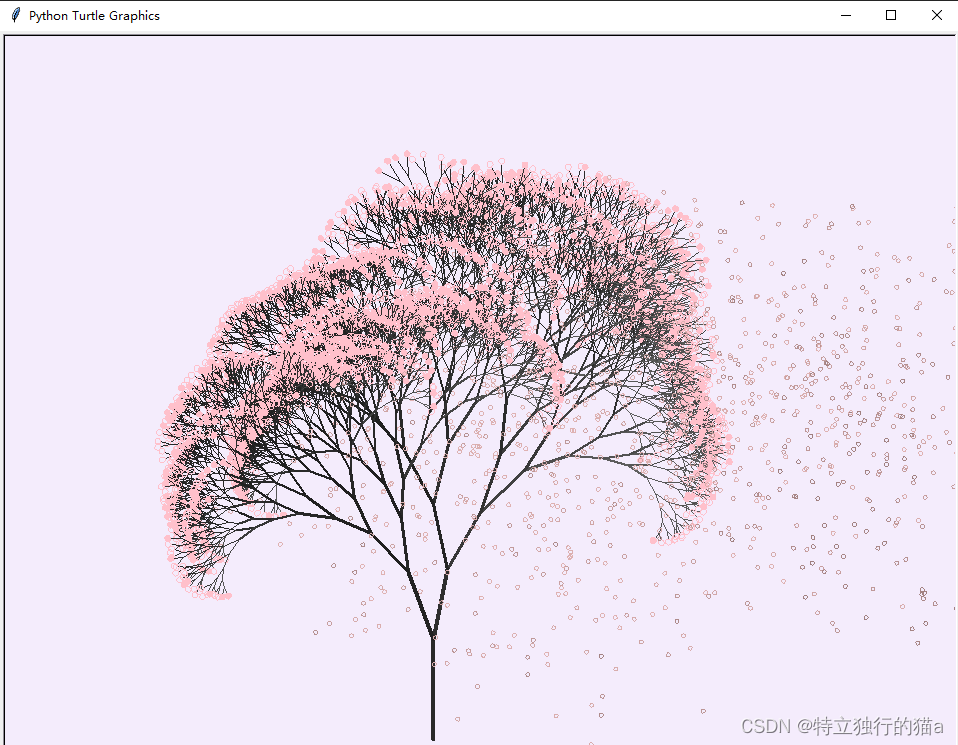
引用出处
海龟绘图 - 廖雪峰的官方网站
python---turtle库(详解)_python turtle_超越ct的博客-CSDN博客
python: turtle绘制有趣的小图像合集_turtle画图作品-CSDN博客
Python Turtle 画图:黑洞里的繁星(附源代码)_turtle绘图代码-CSDN博客
Python海龟turtle基础知识大全与画图集合_python海龟编程代码大全-CSDN博客
Python — — turtle 常用代码_python海龟编程代码大全-CSDN博客
Python海龟画图集合_香自寒来-华为云开发者联盟
